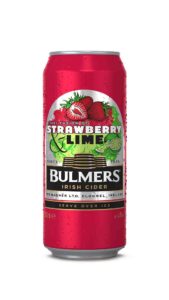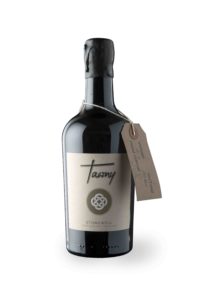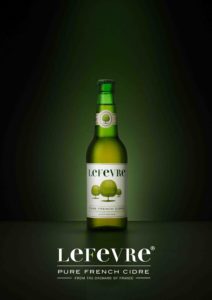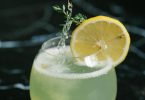2016’s cider market
While Ireland itself may be emerging from the depths of recession, globally, cider is seen as a hip new product and has become one of the fastest-growing sub-segments of the LAD market around the world. That’s good news for cider producers everywhere.
Mike Beck, head of the Cider Association in the US, believes that If cider was a style of beer, it would be the second-biggest selling one in the US thanks to its rising popularity there where the cider market has grown 65% each year for the past three years.
In its Q3 Outlook for 2015 on cider, Rabobank had stated that, “Brands are proliferating in the global market as traditional cider brands extend their product ranges. Beer companies are extending their beer brand to cider and launching bold new brands to corral consumers and to reach new generations. But in addition to novelty, more and more brands are successfully incorporating some suggestion of authenticity which we know is increasingly valued by all generations of consumers.”
But Rabobank’s cider market observer Francois Sonneville sees a potential break in the trend.
“Last year, the US was behind the strong global volume growth in cider consumption but, although 2015 has seen this continue, there are signs that volume growth in the US has slowed in recent weeks,” he told Drinks Industry Ireland.
There are three reasons he can think of that might have caused this slowdown:
1. In the US, almost all cider is made of apples. Flavoured ciders are taxed differently and whereas in the UK flavoured cider accounts for roughly 20% of cider volume and has been growing, in the US it makes up only 1% to 2%. Cider consumers looking for sweeter products (eg those who switch from wine) are mostly interested in flavoured ciders. In the US, this group is not serviced well by the cider industry and competing products like alcoholic root beer and hard sodas are taking their place.
“With root beer coming to the UK and Ireland, we might see some impact on flavoured cider growth in 2016 although this sub-category still has good momentum over here. In the US, changes in regulation might help the apple/pear ciders a bit in 2016 but for flavoured cider this looks like too little, too late.”
2. Not only cider but also craft beer is facing headwind in the US as growth rates come down rapidly. The most obvious victim of this development is Boston Beer, the largest craft and cider player in the US.
Of the largest US craft beers, four have been bought by big brewing companies recently and perhaps consumers are no longer convinced that the product they’re buying is truly craft. Consumes might have moved on to smaller craft brands that are not registered as well by research companies such as AC Nielsen. The sector could still be doing well, but the smaller craft ciders (who’re below the radar screen) continue to take market share from the established players.
3. With beer volume in the US stabilising in recent weeks, he wondered whether we’re starting to see down-trading happening in the market (drinking the same quantity but cheaper), perhaps driven by fear for a downturn in the economy? What goes against this however is developments within portfolios, points out Francois. For ABI, US premium brands perform better than their US core brands and Heineken, which is in the import segment, is also doing better than average. Finally, Craft Brew Alliance performed well. There seems to be room for segmentation, but positioning of products needs to be right, implying that there is a market for super-premium ciders, but only when the message and the actual product match, he says.
“Predicting the future for cider has become much more difficult in recent weeks,” Francois continues, “It’s still true that the category is very small versus (craft) beer in the US as well as in many other parts of the world outside UK and Ireland.
“For Millennials willing to experiment with new products cider is a very good alternative to mainstream beer and more market share can be won over time. The nature of the new consumer will however mean that the growth path will be volatile and irregular. A risk is that major beer companies that own cider brands in a large beverage portfolio are shifting their attention to other flavoured alcoholic beverages, weakening the push strategy for the category.”
UK and Ireland
Nearer home, roughly two-fifths of the global cider market is consumed in the UK and Ireland with 46% of UK adults regularly drinking cider.
Cider consumption showed significant growth in both the Irish and UK markets as a result of innovations in cider in the mid-noughties.
However today, unlike the UK where cider accounts for some 20% of total LAD consumption, Ireland’s cider market accounts for just 8% indicating that there’s still considerable potential in the Irish market for cider.
This is especially so when one considers that cider’s appeal is equally strong to both males and females with cider appearing to be the most preferred drink in the 18-24 year-old consumer segment in the UK market.
And the category is also achieving some degree of success in moving cider away from ‘seasonality’.
A CGA Peach BrandTrack survey last July revealed that 77% of UK consumers drink cider throughout the year as opposed to the 34% who only drink cider when the weather is good.
“When in a beer garden or outdoors, cider is more appealing to me,” concurred 66% of consumers while 63% thought that, “When it is warm, cider is a more fashionable choice of drink”.
But there’s more to it than that. If RaboBank’s Francois Sonneville is right, ciders today must be ‘on-tend’ to satisfy the Millenials in your bar.
Demand in Ireland
Here in Ireland, the 60 million litre cider category forms such an integral part of every pub’s repertoire that while it’s fortunes may rise and fall it remains a constant at the bar counter and in the coolers. Down the years, cider continues to occupy a steady 8% of Ireland’s LAD market.
Last year, cider witnessed a decline of around 3.3% in the Long Alcoholic Drinks category. This comprised a fall of 5.3% in on-trade volume and a decline of 1.6% in off-trade volume, according to Heineken Ireland which enjoys a 5.4% of the market via its Orchard Thieves, Symonds, Scrumpy Jack and Stonehouse portfolio.
And since its launch last May Orchard Thieves has grown to become the third-biggest cider brand in the on-trade and the fourth-biggest brand in the off-trade channel, commanding 4.3% of the total cider market.
Heineken’s Trade Marketing Innovations Manager Heidi McCaughey expects this growth to continue into 2016 as Heineken Ireland expands its draught and bottle account base.
As the cider category in Ireland continues to lose share to other Long Alcohol Drinks, the biggest brand in the market, Bulmers, admits to losing ground to “the distribution build of new arrivals”.
So stated C&C in a trading update for the 12 months to 29th February 2016 released ahead of its Capital Markets Day in London.
However, the statement also continues, “compelling rate of sale data for Bulmers should prove to be a key feature in performance stabilisation in FY17”.
Fruit-flavoured cider
As is the case in the UK, Irish flavoured ciders are showing growth albeit from a small base as Heidi McCaughey points out.
“Consumer tastes are changing and people are experimenting more and more with flavours in both cider and lager,” she says, “While flavoured ciders make up only a small share of on-trade cider volume, they are growing.”
She’d put their share of the on-trade cider market at around 4%.
Orchard Thieves launches ‘Orchard Thieves Light’
A lighter alternative for Orchard Thieves fans
This April Orchard Thieves launches Orchard Thieves Light, a refreshing alternative for consumers who’re counting their calories but don’t want to compromise on taste. Orchard Thieves Light (ABV 4.5%) boasts 33% less sugar than Orchard Thieves at just 28 calories per 100ml.
In 2015 Heineken Ireland launched Orchard Thieves and it’s now the fastest-growing cider brand in the on-trade. This new extension will further invigorate the category and satisfy those looking for a lighter alternative during the warm weather.
Available in pint bottle in the on-trade, it’s priced in line with the current Orchard Thieves price point to sit alongside Orchard Thieves in fridges.
Now available from wholesalers, the launch is supported from May with Through-The-Line support, Out-Of-Home on six sheets countrywide, social media via Orchard Thieves facebook & twitter pages (over 20,000 followers) and sampling in 1,500 accounts nationwide, trialing a 15cl mini-can and pint bottle directly to consumers.
To drive visibility Orchard Thieves Light is introducing vibrant POS and useful dripmats to inform consumers at the Point-Of-Purchase.
“Since launch last May Orchard Thieves has reinvigorated the cider category and is now the fastest-growing cider in the on trade,” commentes Michelle O’Rafferty, Senior Activations Manager for Heineken Ireland, “Introducing Orchard Thieves Light is the natural next step for the brand, thieving the calories from Orchard Thieves but not the taste!”
#BeBold | facebook.com/OrchardThievesCider | @OrchardThieves
If anyone can – Bulmers can
Strap: Bulmers introduces canned Bulmers Forbidden Flavours
Following last year’s successful launch of Bulmers Forbidden Flavours Ireland’s original cider-maker has launched the four fruity ciders – Cloudy Lemon, Strawberry & Lime, Juicy Pear and Berry Berry – in 500ml can format for the off-trade.
Produced in Clonmel alongside all Bulmers variants, Bulmers Forbidden Flavours burst with refreshing fruity cider and has proven a big hit with those looking for a drink with a bit of an edge and a touch of natural sweetness.
Flavoured cider holds 8% of the off-trade cider market and experienced growth in the last six months of 22% on the pervious year with Bulmers Forbidden Flavours accounting for almost half of this growth.
Across the off-trade, 68% of consumers consistently prefer their LAD canned than bottled so there’s a strong rationale for introducing the Flavours variant in this new format.
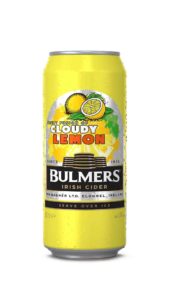 “The reaction from both the trade and consumers to Bulmers Forbidden Flavours, which had previously only been available in glass bottle format, has been hugely positive,” said Fiona Collins, Bulmers’ Brand Manager, “Therefore extending our off-trade packaging to include a can format was a natural evolution for the brand.”
“The reaction from both the trade and consumers to Bulmers Forbidden Flavours, which had previously only been available in glass bottle format, has been hugely positive,” said Fiona Collins, Bulmers’ Brand Manager, “Therefore extending our off-trade packaging to include a can format was a natural evolution for the brand.”
The Bulmers Forbidden Flavours range features:
- Cloudy Lemon, the first-to-market Irish cider with blends of natural lemon and citrus flavours
- Strawberry & Lime, combining the sweet juiciness of ripe strawberries with a super-refreshing twist of tangy lime
- Berry Berry, the original apple cider infused with blackcurrants, raspberries and strawberries
- Juicy Pear, slowly fermented to maximise flavour.
The new pack format will star at all the best festivals across the Summer including Forbidden Fruit at the Royal Hospital Kilmainham, Body & Soul, Bulmers Live at Leopardstown and Metropolis at the RDS.
High-profile sampling and full Below-The-Line activity supports the launch.
“We’ll introduce promotional offers at intervals across the year as we know that Flavours retain their popularity across all four seasons which is good news for the cider market and great news for consumers,” Fiona Collins added.
Craft Ciders
Craft ciders too are beginning to make a name for themselves. Such ciders differentiate themselves by shunning use of concentrate, preferring to work with the more time-, space- and labour-consuming pure apple.
“Not one craft cider producer is using concentrate in manufacture at the moment,” claims Daniel Emerson of Stonewell cider in Kinsale, County Cork. And this is perhaps craft cider’s saving grace and Point of Difference when it comes to premium pricing.
“If you make that jump then you’re competing directly with commercial brands,” he says, “We have to pay for that juice, that storage and that labour so the USP justifies the premium price status of craft cider.”

Daniel Emerson: “We have to pay for that juice, that storage and that labour so the USP justifies the premium price status of craft cider.”
He reckons that over the past 12 months the craft cider market will have grown but not as quickly as expected.
“It’s probably doubled but won’t be much more than 3 or 4% of the cider market,” he tells Drinks Industry Ireland.
Craft cider producer Ger Callinan of Lefevre Cider seems similarly sanguine, stating, “Craft ciders now account for around 2% of the cider market in Ireland which may seem relatively small but we anticipate it to increase to between 6-8% within five years.”
He’d estimate that the craft cider consumption market is 60% female with the majority of consumers aged between 23 and 40.
The ‘seasonality’ of cider has yet to be successfully overcome too, says Daniel Emerson.
Cider is seen as being for thirst-quenching during a sunny day and ‘craft’ competes with ‘commercial’ by differentiating itself, offering light crisp versions to more ‘meaty’ beverages which might be matched to beef or lamb.
“Getting this versatility across is a question of time,” says Daniel, “The challenge is to make people aware of what’s out in the market.”
Ger Callinan agrees.
“Dry, medium, sweet and flavoured ciders are the generic styles but craft cider producers are now pushing the boundaries of the cider categories” he claims, “for example our medium style cidre is sweet on the tongue but has a long dry finish and our customers love this complexity.”

Ger Callinan: “Craft ciders now account for around 2% of the cider market in Ireland which may seem relatively small but we anticipate it to increase to between 6-8% within five years.”
Daniel also notes a change in consumption profiles.
“We had five SKUs of which medium dry comprised 95% but now that’s more like 75% as we’re seeing a much larger take-up of cry ciders.”
He attributes this drift to a more educated consumer and an evolving palate.
“Ironically enough” he adds, “to my surprise those palates that seem to enjoy the drier ciders are female as a rule. And typically, it’s the males who prefer ciders medium dry to sweeter.”
But can the craft cider movement still rely on consumer and retail willingness to support locally-produced product?
“Yes” believes Daniel Emerson, “There’s still a great deal of emphasis on provenance of cider however we’re not immune to the levels of fatigue that are currently being experienced in the microbrewery sector which may not be so applicable to us yet.”
There’s a recognition that you can only bring so many new products to market at one time, he says.
“Consumers and retailers are still supporting the craft ciders” agrees Ger Callinan, “as the consumers are now looking for a choice of high quality ciders and the retailers are happy to provide it.”
Cider development may yet involve a new lexicon of ‘niche’, ‘cloudy’, ‘vintage’ and ‘barmy’ descriptors – a magnet to true craft cider lovers if highlighted at the bar.
But perhaps it’s too early to spot these non-commercial ciders in the on-trade as yet where ‘bright’ product is the cider rule.
“I would say that the Irish cider consumer is much more aware of quality now than ever before,” believes Emma Tyrrell, Chairperson of Cider Ireland, the trade association for the country’s craft cider-makers, “The craft beer movement has spread into the world of apples as much as it has in the world of hops. People are ready for a change and ready to explore what they see as a more natural product.
“That said we’re still not where, say, the US is yet and the reality is that the volumes of craft cider being produced in Ireland are still small.”
Daniel Emerson sums up: “The key challenge is getting it to market which is going to confront the entire micro market in both beer and cider.”
Until then, premium ciders may well hold the key to differential demand.
Stonewell – Variety is the Spice of Life
With substantial expansion of its production facility Stonewell pressed the equivalent of over 750 tonnes of apples in the 2015 harvest – its largest amount to date!
The apples from Laois, Kilkenny & Waterford contribute to all of Stonewell’s juice-only ciders and its increasing appeal across the country.
Having shaken the market up with its dry hopped cider port, Tawny, Stonewell will launch a novel seasonal cider this Summer. Coupled with an increasing number of draught accounts the company is preparing for an even bigger harvest this year.
“The renaissance of real cider in Ireland is gathering pace and it’s great to see that the consumer is becoming more demanding of both the variety and quality of the finished article,” says Daniel Emerson, one half of the husband-and-wife team that founded the business from their small farm in 2010.
“We’re hoping to continue to delight our customers with some of the new blends we’re creating and working closely with our partner Classic Drinks we’re confident that we can ensure that our ciders are delivered across the country with consistency and excellent quality of service,” he states.
Stonewell Cider makes cider only from fresh juice, using traditional methods by its small team based in County Cork.
For your local Business Development Manager – please contact Classic Drinks on 021 4510066 or sales@classicdrinks.ie.
Lefevre Cider
In the North-West of France, the fruit of the earth is not the grape. It’s the apple and for more than 200 years the Lefevre family has been crafting artisan cider on its farmlands in Berville, Picardy.
The Lefevre family cider had never been sold to a wider audience until Eric Lefevre began working with Irishman Ger Callanan. The pair were friends and colleagues in the Irish financial sector and once they realised the potential for Lefevre Cidre they launched their Franco/Irish company in Ireland in the Summer of 2014. Since then the brand has been growing from strength-to-strength scooping up awards both sides of the sea. Lefevre Cidre is now readily available in Ireland, UK & France.
“We’re making really fine quality French cidre from 100% pressed apple-juice using traditional French methods whilst giving our brand a fresh contemporary design,” comments Ger.
Lefevre Pure French Cidre (medium style) is a sparkling cidre made with a blend of seven apple varieties. Golden amber in colour with fine bright agile bubbles, it’s sweet on the tongue and has a long dry finish. Now available on draught in 30L kegs and in 330ml bottles.
This April Lefevre launches its second core cidre, Lefevre Cidre Brut, a dry cidre fermented at low temperatures and aged for up to five months to deliver a beautiful golden auburn colour, an aroma that hints of licorice and a fruity taste enlivened by the Lefevre signature agile bubbles.
Lefevre Cidre is available to the trade via Barry & Fitzwilliam. For more information please visit its website http://www.lefevrecidre.com
Longueville House
Longueville House has been fermenting cider and distilling Ireland’s only brandy now for over 20 years; we only use heritage, heirloom cider apples, namely Michelin and Dabinett, grown in our orchards on the estate of the 18th Century Country Manor House Hotel in the beautiful Blackwater valley in Cork.
Longueville House Cider (ABV 5%) is all-natural with no additives, no preservatives and no added sugars, resulting in a really crisp, refreshing and clean cider, a real thirst-quencher in the Summer and it’s equally delicious hot in the late Autumn and Winter (please see our facebook page for the recipe).
The cider is double-distilled and then aged for four years in French oak red wine casks to mature and develop, yielding an absolutely awesome and sublimely smooth, full-bodied Apple brandy (ABV 40%), best enjoyed after a really good meal. The perfect digestif! It’s the only spirit to have won Gold at Blas na hEireann three years running back-to-back.
Our new cider Longueville Mor is punching above its weight at ABV 8% – a combination of our Longueville House Cider and our Apple Brandy with significantly more taste and character, a truly delicious and unique cider.
Our ciders and brandy can be ordered direct from the Hotel or through our network of distributors:- Barry & Fitzwilliam or Barry Group or Vanguard or by e-mailing saleslonguevillebeverages@gmail.com or phoning 022-41756.
Contact us direct too to arrange guided tours of our orchards, cidery & distillery.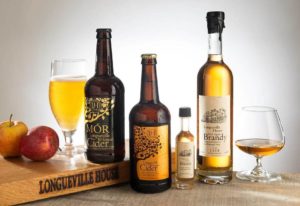



![ProEXR File Description =Attributes= cameraAperture (float): 36 cameraFarClip (float): 1000 cameraFarRange (float): 1000 cameraFov (float): 8.62179 cameraNearClip (float): 0 cameraNearRange (float): 0 cameraProjection (int): 0 cameraTargetDistance (float): 200 channels (chlist) compression (compression): Zip16 dataWindow (box2i): [0, 0, 2809, 4999] displayWindow (box2i): [0, 0, 2809, 4999] gamma (float): 1 lineOrder (lineOrder): Increasing Y pixelAspectRatio (float): 1 screenWindowCenter (v2f): [0, 0] screenWindowWidth (float): 1 type (string): "scanlineimage" =Channels= A (float) B (float) G (float) R (float)](https://www.drinksindustryireland.ie/wp-content/uploads/2016/05/Orchard-Thieves-Lightlow-169x300.jpg)
